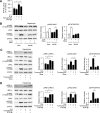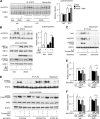Endoplasmic reticulum stress inhibits STAT3-dependent suppression of hepatic gluconeogenesis via dephosphorylation and deacetylation
- PMID: 22124464
- PMCID: PMC3237645
- DOI: 10.2337/db10-1684
Endoplasmic reticulum stress inhibits STAT3-dependent suppression of hepatic gluconeogenesis via dephosphorylation and deacetylation
Abstract
In the liver, signal transducer and activator of transcription 3 (STAT3) plays an important role in the suppression of gluconeogenic enzyme expression. While obesity-associated endoplasmic reticulum (ER) stress has been shown to increase hepatic gluconeogenic enzyme expression, the role of ER stress in STAT3-dependent regulation of such expression is unclear. The current study aimed to elucidate the effect of ER stress on the STAT3-dependent regulation of hepatic gluconeogenic enzyme expression. Genetically obese/diabetic db/db mice and db/db mouse-derived isolated hepatocytes were used as ER stress models. A tyrosine phosphatase inhibitor, a deacetylation inhibitor, and an acetylated mutant of STAT3 were used to examine the effect of ER stress on hepatic STAT3 action. ER stress inhibited STAT3-dependent suppression of gluconeogenic enzyme gene expression by suppressing hepatic Janus kinase (JAK)2 and STAT3 phosphorylation. A tyrosine phosphatase inhibitor restored ER stress-induced suppression of JAK2 phosphorylation but exhibited no improving effect on suppressed STAT3 phosphorylation. STAT3 acetylation is known to correlate with its phosphorylation. ER stress also decreased STAT3 acetylation. An acetylated mutant of STAT3 was resistant to ER stress-induced inhibition of STAT3-phosphorylation and STAT3-dependent suppression of hepatic gluconeogenic enzyme gene expression in vitro and in vivo. Trichostatin A, a histone deacetylase (HDAC) inhibitor, ameliorated ER stress-induced inhibition of STAT3 acetylation and phosphorylation. The current study revealed that ER stress inhibits STAT3-dependent suppression of hepatic gluconeogenic enzymes via JAK2 dephosphorylation and HDAC-dependent STAT3 deacetylation, playing an important role in the increase of hepatic glucose production in obesity and diabetes.
Figures








Similar articles
-
Baicalin regulates SirT1/STAT3 pathway and restrains excessive hepatic glucose production.Pharmacol Res. 2018 Oct;136:62-73. doi: 10.1016/j.phrs.2018.08.018. Epub 2018 Aug 23. Pharmacol Res. 2018. PMID: 30144531
-
STAT3 inhibition of gluconeogenesis is downregulated by SirT1.Nat Cell Biol. 2009 Apr;11(4):492-500. doi: 10.1038/ncb1857. Epub 2009 Mar 22. Nat Cell Biol. 2009. PMID: 19295512 Free PMC article.
-
Inhibition of SphK2 Stimulated Hepatic Gluconeogenesis Associated with Dephosphorylation and Deacetylation of STAT3.Arch Med Res. 2018 Jul;49(5):335-341. doi: 10.1016/j.arcmed.2018.11.001. Epub 2018 Nov 16. Arch Med Res. 2018. PMID: 30448236
-
T-cell protein tyrosine phosphatase attenuates STAT3 and insulin signaling in the liver to regulate gluconeogenesis.Diabetes. 2010 Aug;59(8):1906-14. doi: 10.2337/db09-1365. Epub 2010 May 18. Diabetes. 2010. PMID: 20484139 Free PMC article.
-
Cerebral Glucose Metabolism and Potential Effects on Endoplasmic Reticulum Stress in Stroke.Aging Dis. 2023 Apr 1;14(2):450-467. doi: 10.14336/AD.2022.0905. eCollection 2023 Apr 1. Aging Dis. 2023. PMID: 37008060 Free PMC article. Review.
Cited by
-
SH003 Causes ER Stress-mediated Apoptosis of Breast Cancer Cells via Intracellular ROS Production.Cancer Genomics Proteomics. 2023 Jan-Feb;20(1):88-116. doi: 10.21873/cgp.20367. Cancer Genomics Proteomics. 2023. PMID: 36581346 Free PMC article.
-
Benefits of Nut Consumption on Insulin Resistance and Cardiovascular Risk Factors: Multiple Potential Mechanisms of Actions.Nutrients. 2017 Nov 22;9(11):1271. doi: 10.3390/nu9111271. Nutrients. 2017. PMID: 29165404 Free PMC article. Review.
-
Prenatal ethanol exposure causes glucose intolerance with increased hepatic gluconeogenesis and histone deacetylases in adult rat offspring: reversal by tauroursodeoxycholic acid.PLoS One. 2013;8(3):e59680. doi: 10.1371/journal.pone.0059680. Epub 2013 Mar 27. PLoS One. 2013. PMID: 23544086 Free PMC article.
-
Acute Endoplasmic Reticulum Stress Suppresses Hepatic Gluconeogenesis by Stimulating MAPK Phosphatase 3 Degradation.Int J Mol Sci. 2023 Oct 25;24(21):15561. doi: 10.3390/ijms242115561. Int J Mol Sci. 2023. PMID: 37958545 Free PMC article.
-
Platelet aggregation elicits FasL expression and hepatocyte apoptosis in sinusoidal obstruction syndrome.Sci Rep. 2025 May 29;15(1):18859. doi: 10.1038/s41598-025-03839-2. Sci Rep. 2025. PMID: 40442395 Free PMC article.
References
-
- Radziuk J, Pye S. Hepatic glucose uptake, gluconeogenesis and the regulation of glycogen synthesis. Diabetes Metab Res Rev 2001;17:250–272 - PubMed
-
- Herzig S, Long F, Jhala US, et al. CREB regulates hepatic gluconeogenesis through the coactivator PGC-1. Nature 2001;413:179–183 - PubMed
-
- Matsumoto M, Pocai A, Rossetti L, Depinho RA, Accili D. Impaired regulation of hepatic glucose production in mice lacking the forkhead transcription factor Foxo1 in liver. Cell Metab 2007;6:208–216 - PubMed
-
- Dentin R, Liu Y, Koo SH, et al. Insulin modulates gluconeogenesis by inhibition of the coactivator TORC2. Nature 2007;449:366–369 - PubMed
Publication types
MeSH terms
Substances
LinkOut - more resources
Full Text Sources
Molecular Biology Databases
Miscellaneous

